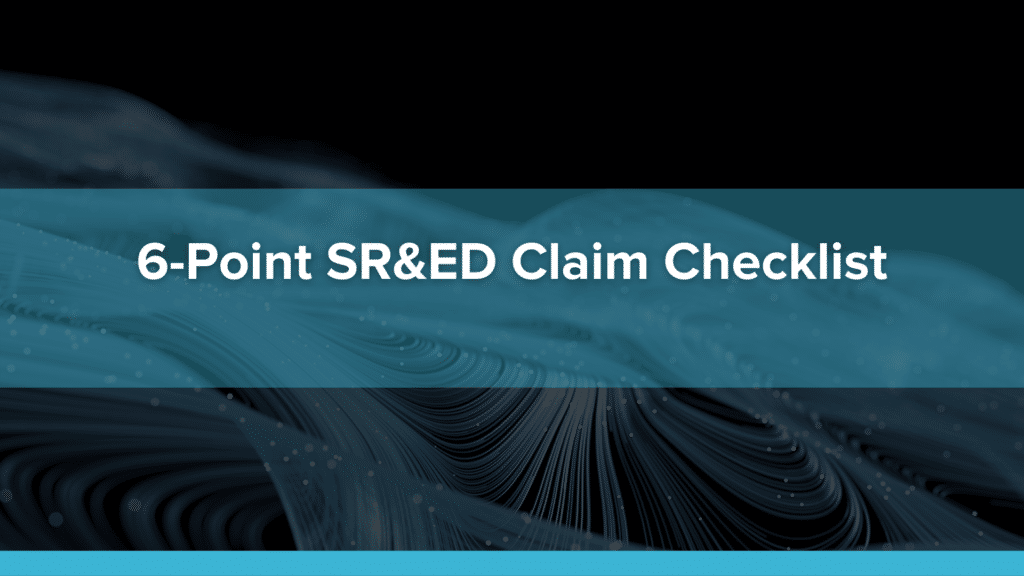The tax season is right around the corner. Not sure if your company can claim that big project your team is working on? Take a moment to review our SR&ED claim checklist to determine whether you’re eligible, and then answer the remaining questions so you can have your items ready for your next claim.
1. Is your R&D project eligible?
The three criteria for determining the SR&ED eligibility of your development work are:
- Technological advancement? In general terms, this means that the work must attempt to increase the technology base or level of understanding from where it was at the beginning of the project.
- Technological uncertainty? In general terms, this means that there were obstacles or challenges that could not have been overcome by applying the techniques, procedures, and data that are generally accessible to competent professionals in the field.
- Technical content? This means that a systematic process for testing a hypothesis must be in place. The objectives of the project must be clearly stated at an early stage and the method of addressing the obstacles or challenges must be set out and followed.
Here are some real-world applications that put the three SR&ED eligibility criteria into practice.
Have you…
[list list_style=”darkGrayDot”]
-
Designed, developed or attempted to develop new software/ systems/tools/products/ processes?
-
Modified an existing technology?
-
Integrated various databases or applications that don’t normally communicate?
-
Added new features, modified or improved an existing product?
-
Improved response time of your software application?
-
Changed a process to reduce costs or to improve manufacturing capabilities/timing?
-
Created a new product, made improvements or added new features to an existing product?
-
Incurred costs related to a process, project, or prototype that is incomplete because of unresolved technical problems?
-
Modified your product formulation?
-
Automated production?
-
Modified existing products or machines to new applications?
-
Machined/fabricated parts/dies using new materials or to meet higher tolerances?
[/list]
If you answered yes to any of the above questions, you have the potential to claim SR&ED.
2. What kind of company are you?
[list list_style=”darkGrayDot”]
- Are you a corporation? Or a different type of entity?
- Are you Canadian-controlled? Or foreign-owned?
- Are you privately-owned? Or public?
- Are you considered an SME within CRA’s definition?
[/list]
There are different return rates depending on the type and size of the company you are as well as whether you’re Canadian-controlled or not.
Canadian-Controlled Private Corporation (CCPC) and SME:
Foreign or Publicly-Owned (Non-CCPC) or Large CCPCs:
(There are also rates for partnerships and proprietorships. Contact us for more details on these rates.)
Bonus: click here to download this 20-page SR&ED Guide to learn everything you need to know to prepare a successful claim.
3. What uncertainties have you overcome?
The following are the three questions that your SR&ED advisor will help you address: (taken straight from Form T661)
[list list_style=”darkGrayDot”]
- What scientific or technological uncertainties did you attempt to overcome – uncertainties that could not be removed using standard practice?
- What work did you perform in the tax year to overcome the scientific or technological uncertainties described above?
- What scientific or technological advancements did you achieve as a result of the work described?
[/list]
4. What have you documented to support your claim?
Start gathering all of your materials. Can you confirm that your documentation is…
- Contemporaneous? It was documented at the time the SR&ED work was done.
- Dated? It proves that the work occurred in the fiscal year you are claiming.
- Highlights technical challenges? It supports the technical reports that will be submitted with the claim.
What counts as proper documentation? [list list_style=”darkGrayDot”]
- Timesheets
- Version control for all technical documents
- Prototypes, including software and physical products
- Test documents
- Developer or Engineering Notebooks
- Meeting minutes
- Whiteboard photos
- Emails
[/list]
For a full read on documentation for SR&ED, check out this post.
5. When is your fiscal year-end?
You must file your claim within 18 months of your fiscal year-end. However, if you file within 6 months, it is considered a current claim and you can receive your return within 68 days, on average. (For SR&ED turnaround times, check out this blog)
6. Who is your SR&ED advisor?
You don’t want to spend your valuable time putting your claim together. It’s tedious, draining, and worst of all takes away time from what you should be focusing on: growing your company!
Find an advisor who has a history of filing SR&ED claims, defending CRA Reviews and an ongoing relationship with the CRA, as well as someone who completely understands your company.
For a list of questions to ask your SR&ED advisor, click here.
[optinform]









